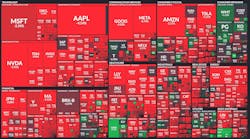President Donald Trump’s tariffs paint pictures of the future U.S. economy: very unfocused pictures.
At one extreme, the import taxes could fundamentally reshape the U.S. economy and its trade routes. Or they could simply be a negotiating tactic that falls flat, producing only empty promises for trade concessions.
Most recently, Trump's postponement of reciprocal tariffs altered global trade, his announcement of a 125% tariff on Chinese imports sent stock valuations tumbling, and China's announcement of 125% retaliatory tariffs Friday, April 11, is poised to cause more panic.
Regardless, tariffs continue to shake the broader economy—and commercial carriers can feel tremors in their own operations. Executives and analysts in the trucking industry told FleetOwner that the duties could challenge fleets’ ease of maintenance, cross-border logistics, and freight demand.
“The bigger risk for trucking is the increased cost of pretty much all goods for the consumer and for businesses … And what that’s going to do to demand, both by consumers for goods as they face higher prices and for businesses looking to decide what they’re going to do in the near term,” Avery Vise, VP of trucking at FTR Transportation Intelligence, told FleetOwner.
See also: Live updates: How Trump's tariffs are shaping trucking today
Cost of ownership, maintenance challenges
Though auto tariffs currently exclude heavy-duty trucks, the 25% tariffs on aluminum and steel imports significantly impact fleets’ costs of ownership. Truck prices could rise—but so could parts prices.
“Steel is going to be heavily impacted,” Michael Quimby, COO of Kooner Fleet Management Solutions and longtime transportation executive, told FleetOwner. “Twenty-five percent, when you translate that down to maintenance, it’s bolts; it’s bars.”
Along with changing part prices, tariffs could influence availability. Kooner is seeing many of its suppliers building up inventory.
“That could, further out, impact parts availability within the industry,” Quimby said. “That’s going to impact the fleet with a longer cycle time to make repairs. … That’s going to impact our clients’ business: As they have trucks sitting down, they may have to rent, or other types of scenarios, where it’s going to increase their total cost.”
Quimby fears that challenges to parts availability could delay preventive maintenance, leading to increased breakdowns for fleets later in the year.
“That increase in breakdowns is going to elevate their costs,” Quimby said.
Kooner is focusing on helping its clients: insulating them from the impact of tariffs by leveraging its relationships with parts suppliers and its predictive analytics technology.
“We have our head on a swivel, looking at anything as a possibility that may impact not only our business but our clients,” Quimby said. “We are working with parts suppliers. We’re inventorying parts here at our facility, and we’re locking in longer contractual agreements with our parts suppliers to maintain our current cost levels.”
Import enforcement could be overwhelmed
Extreme fluctuations in tariff enforcement could continue to repeatedly overwhelm customs personnel and require logistics operations to pivot to a new trade environment.
“The burden of enforcing new trade policies is beyond the capacity of existing organizations and tools. CBP (Customs and Border Patrol) and the yet-to-be-established ERS (External Revenue Service) will need to rise to the challenge,” Ram Ben Tzion, co-founder and CEO of Publican Trade Solutions, said. “Logistics operators will need to increase customs processing and clearance capacity to handle all new regulations and tariff requirements. This will not be a smooth ride.”
See also: Fleet Advantage launches tariff-readiness program
Business paralysis continues
Tariff talks have slowed down business decisions for several months. Trump’s 90-day pause exacerbated the problem—that came less than a week after he said his nearly worldwide “reciprocal” import tax was permanent. That “pause” still puts at least a 10% duty on most imports and up to 125% on Chinese goods.
FTR’s Vise thinks that some of the greatest challenges for trucking will come from heightened costs and stalled business decisions. The firm is forecasting weaker economic growth in the face of tariffs.
“It has frozen a lot of plans by businesses—whether they want to expand, whether they want to invest—because they don’t know what the environment is going to be like,” Vise told FleetOwner. “That just freezes the economy in a lot of ways. …. People might be bringing in additional stuff to beat tariffs, but for the most part, they’re on the sidelines trying to decide whether to make investments.”
Trump's current tariffs:
As of April 11, here are the broad duties that Trump has enacted—not including the innumerable carveouts for goods such as semiconductors and valuable minerals:
- All imports: at least 10%
- Imports from China: 125%
- Non-USMCA imports from Canada, Mexico: 25%
- All steel and aluminum imports: 25%
- Foreign automobile imports: 25% (excludes heavy-duty trucks)
Those businesses bringing in goods to beat tariffs have kept freight demand strong. Vise noted that surges in volumes for flatbed—and some strength for dry van and refrigerated loads—suggest companies are still pulling goods forward early. It may take a week or two to see how tariffs could depress demand.
“Overall, we don’t have any indication of softening freight demand yet,” Vise said. “We expect that Q1 will turn out to be strong on imports and Q2 will be weak. But after that, it will normalize, and that’s because you’re only going to bring so much inventory ahead.”
Vise is not concerned that the trucking sector will face a hangover from this pull forward of goods: Much of the surge in imports came from gold bullions, computers, and pharmaceuticals.
“Those are very low truck freight impact categories,” Vise said. “The concern is not so much the downturn from those imports, but more what these costs are going to mean for companies that have to pass them along to consumers—and what that’s going to do to trucking activity and to the overall economy.”
Rising costs for consumers
Consumer confidence is falling—while their debt and delinquencies are rising. In this fragile position, spiking prices will mean fewer purchases from consumers.
“The bigger risk for trucking is the follow-on impact, which is the increased cost of pretty much all goods for the consumer and for businesses … And what that’s going to do to demand, both by consumers for goods as they face higher prices and for businesses looking to decide what they’re going to do in the near term,” Vise said.
John Lash, group VP of product strategy for e2open, said that the cost of tariffs will ultimately dampen demand.
“The vast majority of these costs will be passed on to consumers, making stuff more expensive in America. Furthermore, declining consumer confidence combined with a spike in prices is likely to tighten wallets, shrinking demand for a wide range of products,” Lash said April 3. “The across-the-board 10% tax on goods from all nations raises a barrier that will affect every importer, no matter who they trade with.”
About the Author
Jeremy Wolfe
Editor
Editor Jeremy Wolfe joined the FleetOwner team in February 2024. He graduated from the University of Wisconsin-Stevens Point with majors in English and Philosophy. He previously served as Editor for Endeavor Business Media's Water Group publications.


